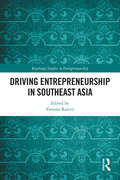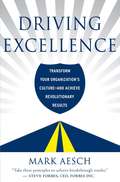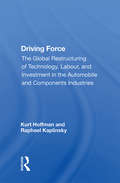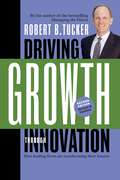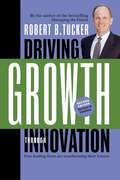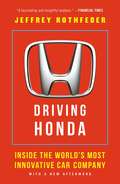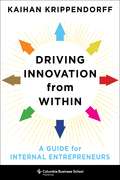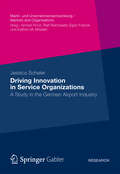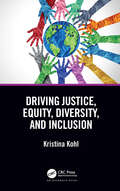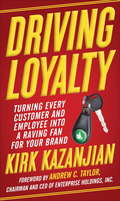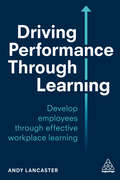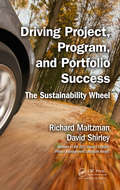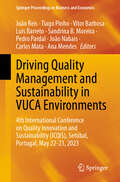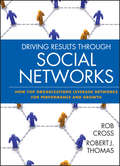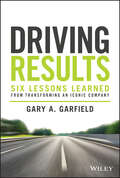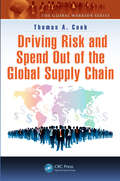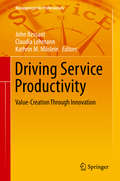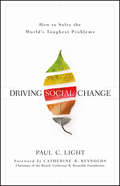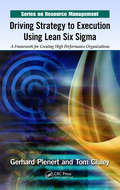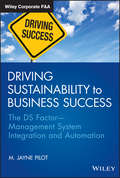- Table View
- List View
Driving Entrepreneurship in Southeast Asia (Routledge Studies in Entrepreneurship)
by Vanessa RattenSoutheast Asia is one of the most dynamic and entrepreneurial regions in the world. Despite its entrepreneurial nature, the study of entrepreneurship has largely been on North America and Europe. This book showcases the entrepreneurial capabilities that are taking place in Southeast Asia from a digital innovation perspective. The book questions the role of entrepreneurship in the Southeast Asian context. It also provides a historical analysis of how entrepreneurship is influenced by the history of individual Southeast Asian countries. It goes on to examine heritage tourism to explore how entrepreneurship is embedded in cultural and social endeavours, and explores how digital technologies and innovations are leading change in the region’s business ecosystems. The book closes by examining the effects of the pandemic from a risk management perspective to show the interrelationship between crisis management and innovation, before highlighting areas for future research. The comprehensive coverage of different countries within Southeast Asia regarding their entrepreneurial initiatives will enrich the existing literature and will be a useful reference to scholars researching entrepreneurship.
Driving Excellence: Transform Your Organization's Culture -- And Achieve Revolutionary Results
by Mark AeschDriving Excellence tells the inspiring story of one man who, with no formal business training, turned an entire industry on its head. Mark Aesch proves that we really can run government like a business, and provide value to taxpayers and shareholders alike.When Aesch took over the Rochester Genesee Regional Transportation Authority in 2004, it was operating with a 27.7-million-dollar deficit, and was poised to raise fares, lay off employees, and slash service. Under Aesch's leadership, those deficits have been eradicated and replaced with multimillion-dollar surpluses; reliance on taxpayer subsidies has been reduced; demand for service has increased at rates three times the national average; and in an unprecedented move, the fare at the Authority's two largest subsidiaries were actually reduced.In Driving Excellence, Aesch shows readers how to create a culture built around selflessness rather than ego, and get employees invested in saving the company. In describing the transition from an ailing business to one that enjoys stunning success--lower fares, multi-million surpluses, and the highest ridership and customer satisfaction levels in twenty years--Aesch offers powerful principles that any organization can implement to achieve exceptional results.
Driving Force: The Global Restructuring Of Technology, Labor, And Investment In The Automobile And Components Industry
by Kurt HoffmanThis book is concerned with the future direction of the international division of labour in manufacturing. It explores the different patterns of foreign direct investment in the eras of machinofacture and systemofacture with respect to a study of the global production of automobile components.
Driving Growth Through Innovation: How Leading Firms Are Transforming Their Futures
by Robert B. TuckerYou’ve read creativity books before, but innovation, as bestselling author Robert B. Tucker explains in this groundbreaking book, is much, much more: it is bringing new ideas to life—to drive growth, profitiablity and competitive advantage. Innovation is fast becoming the critical business skill of the 21st century. Driving Growth Through Innovation will take you behind the scenes to learn the winning methods behind some of the most exciting breakthroughs of our time. You will find out how innovators at Colgate-Palmolive brainstormed a product—Colgate Total—that unseated Crest to become the world’s leading toothpaste brand. Learn how Citigroup, the world’s largest financial services company, has used its global innovation initiative to generate fifteen to twenty percent of their revenue from products that have been introduced in the previous two years. Witness a highly unconventional, even controversial, focus group that Daimler Chrysler used to design the breakthrough PT Cruiser. Get the true story of how developers at Maytag used their experiences with designing the revolutionary Neptune washer to jumpstart growth in a mature market. And how Dana Corporation consistently elicits two ideas per month per employee with a stunning eighty percent implementation rate. This second edition has been revised and updated throughout and includes a self-assessment instrument so that readers can evaluate the innovation culture and practices of their organizations, as well as a discussion of the newly emerging position of chief innovation officer.
Driving Growth Through Innovation: How Leading Firms are Transforming Their Futures
by Robert B. TuckerIn this book, Robert B. Tucker provides a practical method any business can use to identify opportunities and encourage innovations that capitalize on them.
Driving Honda
by Jeffrey RothfederFor decades there have been two iconic Japanese auto companies. One has been endlessly studied and written about. The other has been generally underappreciated and misunderstood. Until now. Since its birth as a motorcycle company in 1949, Honda has steadily grown into the world's fifth largest automaker and top engine manufacturer, as well as one of the most beloved, most profitable, and most consistently innovative multinational corporations. What drives the company that keeps creating and improving award-winning and bestselling models like the Civic, Accord, Odyssey, CR-V, and Pilot? According to Jeffrey Rothfeder, what truly distinguishes Honda from its competitors, especially archrival Toyota, is a deep commitment to a set of unorthodox management tenets. The Honda Way, as insiders call it, is notable for decentralization over corporate control, simplicity over complexity, experimentation over Six Sigma-driven efficiency, and unyielding cynicism toward the status quo and whatever is assumed to be the truth. Honda believes in freely borrowing from the past as a bridge to "innovative discontinuity" in the present. And those are just a few of the ideas that the company's colorful founder, Soichiro Honda, embedded in the DNA of his start-up sixty-five years ago. As the first journalist allowed behind Honda's infamously private doors, Rothfeder interviewed dozens of executives, engineers, and frontline employees about its management practices and global strategy. He shows how the company has developed and maintained its unmatched culture of innovation, resilience, and flexibility--and how it exported that culture to other countries that are strikingly different from Japan, establishing locally controlled operations in each region where it lays down roots. For instance, Rothfeder reports on life at a Honda factory in the tiny town of Lincoln, Alabama, and what happened when American workers were trained to follow the Honda Way, as a self-sufficient outpost of the global company. Could they master Honda's three core principles: Embrace Paradox: Honda encourages respectful disagreement and debate between opposing viewpoints, on matters large and small. New ideas often emerge from conflict. Real Place, Real Part, Real Knowledge: Honda teaches people to argue using facts, not assumptions. One must go to the factory floor, the showroom, the parking lot, the driver's seat, or the truck bed--whatever it takes--to get the facts and make a decision that can be supported with data. Respect Individualism: Honda often hires people with unusual backgrounds and independent streaks. It promotes those who question the status quo and who would probably struggle in organizations that focus on rigid rules and systems. Rothfeder shows how the Alabama plant became a new model for manufacturing in America. It can turn out several different types of cars on any given day and up to 300,000 vehicles and engines a year. Its flexible model enables unparalleled responsiveness to market changes and recovery from mistakes. As Soichiro Honda himself liked to say, "Success can be achieved only through repeated failure and introspection. In fact, success represents one percent of your work, which results only from the ninety-nine percent that is called failure."
Driving Honda
by Jeffrey RothfederSince its birth as a motorcycle company in 1949, Honda has steadily grown into one of the world's largest automakers and engine manufacturers, as well as one of the most beloved, most profitable, and most consistently innovative multinational corporations. What drives the company that keeps creating and improving award-winning and bestselling models like the Civic, Accord, Odyssey, CR-V, and Pilot?According to Jeffrey Rothfeder, what truly distinguishes Honda from its competitors, especially archrival Toyota, is a deep commitment to a set of unorthodox management tenets. The Honda Way, as insiders call it, is notable for decentralization over corporate control, simplicity over complexity, experimentation over Six Sigma-driven efficiency, and unyielding cynicism toward the status quo and whatever is assumed to be the truth. Those are just a few of the ideas that the company's colorful founder Soichiro Honda embedded in the DNA of his start-up sixty-five years ago.As the first journalist allowed behind Honda's infamously private doors, Rothfeder interviewed dozens of executives, engineers, and frontline employees about Honda's management practices and global strategy. He shows how the company developed and maintained its unmatched culture of innovation, resilience, and flexibility--and how it exported that culture to other countries that are strikingly different from Japan, establishing locally controlled operations in each region where it lays down roots.From the Trade Paperback edition.nciples:Embrace Paradox: Honda encourages respectful disagreement and debate between opposing viewpoints, on matters large and small. New ideas often emerge from conflict.Real Place, Real Part, Real Knowledge: Honda teaches people to argue using facts, not assumptions. One must go to the factory floor, the showroom, the parking lot, the driver's seat, or the truck bed--whatever it takes--to get the facts and make a decision that can be supported with data.Respect Individualism: Honda often hires people with unusual backgrounds and independent streaks. It promotes those who question the status quo and who would probably struggle in organizations that focus on rigid rules and systems.Rothfeder shows how the Alabama plant became a new model for manufacturing in America. It can turn out several different types of cars on any given day and up to 300,000 vehicles and engines a year. Its flexible model enables unparalleled responsiveness to market changes and recovery from mistakes. As Soichiro Honda himself liked to say, "Success can be achieved only through repeated failure and introspection. In fact, success represents one percent of your work, which results only from the ninety-nine percent that is called failure."
Driving Innovation from Within: A Guide for Internal Entrepreneurs (Columbia Business School Publishing Ser.)
by Kaihan KrippendorffConventional business wisdom tells us that entrepreneurs are society’s main source of innovation. Young founders leave college with a big idea, get to work in a garage, and build something that changes the world. Typical corporate employees, strangled by slow-moving bureaucracy, are blocked from making transformative discoveries.In Driving Innovation from Within, strategist and advisor Kaihan Krippendorff disproves one of today’s biggest business myths to highlight lessons for innovators and leaders. He reveals how many of the modern world’s most impactful creations were invented by passionate employee innovators. If it were left up to go-it-alone entrepreneurs, we would not have mobile phones, personal computers, or e-mail. Distilling more than 150 interviews with internal innovators and leading experts along with insights from the latest research and today’s most successful companies, from Tencent and Amazon to Mastercard and Starbucks, Krippendorff lays out a step-by-step playbook to unlock innovation from the inside. He maps the barriers that frustrate efforts to disrupt from within and provides tools to remove them, detailing how visionary leaders can create islands of freedom inside an organization to activate existing employees’ potential and beat startups at their own game. Driving Innovation from Within is a practical and inspiring guide to leadership from all levels for those who want the fulfillment of changing the world without leaving their job in order to do it.
Driving Innovation in Service Organisations
by Jessica SchelerWith an ever increasing globalization of the economy, rapid technological progress, and intensifying competition, service firms such as airports constantly have to fuel the engine of renewal to keep on prospering. Nevertheless, research is still left with the critical question how service firms can manage their ability to innovate. By applying a resource perspective, Jessica Scheler explores drivers and barriers affecting the ability to innovate in the airport industry. Findings reveal significant categories and deliver valuable findings for academia and managerial practice particularly with regard to leadership issues, organizational structure, and roles of individuals.
Driving Justice, Equity, Diversity, and Inclusion
by Kristina KohlNavigating the volatility, uncertainty, complexity, and ambiguity (VUCA) characterizing the business world in the 21st century requires a new paradigm focused on an integrated bottom line – planet, people, and profit (PPP). Global trends include resource scarcity and growing inequities in income, wealth, education, and healthcare. Stakeholders are demanding that organizations address systemic barriers to promote justice and equity within organizations and across broader social systems. Transformational change requires leadership to analyze internal and external systems through a social and environmental justice lens. Despite a growing focus on justice, equity, diversity, and inclusion, the imbalance of power remains within our institutions, organizations, and social systems. To move the needle, leaders can turn to Driving Justice, Equity, Diversity, and Inclusion, which explains developing a North Star vision and creating a strategy to redesign organizational process and systems, as well as leveraging tools for data-driven decision-making. It presents a framework to build an inclusive organization as well as a model to engage and support senior and middle management beginning the process of capacity building and systemic change. By layering in AI and other technologies to support data-driven decision-making, the book guides leaders in navigating their organization’s journey along the maturity continuum to achieve their North Star vision of becoming a just and equitable organization. The book also helps managers to Assess ecosystems and organizational systems that justice, equity, diversity, and inclusion impact Take a deeper dive into transformational and operational components to gain insights on the deep systemic realignment of the North Star vision Identify and engage with diverse stakeholders to gain perspective and understand issues crucial for transformative change Leverage people-centered design to create a process promoting diversity of voices and to better align outcomes with shared organizational vision Use data to drive decision-making and reduce bias by removing intuition from the decision-making process Leverage the book's frameworks to drive collaborative systemic change Adapt insights highlighted in multiple interviews with DEI practitioners Benefit from lessons learned and best practices featured in the book's case studies This book features a primer, which is a quick reference guide to key terms, concepts, and definitions. It helps to define justice, equity, diversity, inclusion, and other key terms, such as unconscious bias, stereotypes, and microaggressions. It also features a toolkit, which includes checklists to help managers lead organizations to realize their own North Star vision.
Driving Loyalty
by Kirk KazanjianMust-reading for every manager, entrepreneur, corporate executive, and anyone looking to increase customer satisfaction, boost employee engagement, and significantly enhance the bottom line.In order to build a successful company today, you must create an unbreakable bond of loyalty between your customers and employees. Few have done this better than Enterprise Holdings, owner of the Enterprise, National, and Alamo rental car brands.While Enterprise has long been known for offering excellent customer service, it faced a huge challenge after buying National and Alamo in 2007. Among other things, it had to integrate different cultures, manage a varied workforce, and meet the needs of a much larger and highly divergent customer base.In Driving Loyalty, you'll get an inside look at how Enterprise began operating these three distinct brands in a way that ultimately led to rising profitability and some of the highest customer and employee satisfaction scores in the industry. You'll also discover how other thriving companies--from JetBlue and Starbucks to Costco and even Chobani Yogurt--use similar techniques to outsmart the competition and turn customers and employees into raving fans.Driving Loyalty provides a blueprint that businesses of all types can use to deliver exceptional customer service, create a high-performing work environment, build strong brands, instill loyalty, market effectively online and off, and, in turn, power overall performance. In the pages of Driving Loyalty, you'll learn:- Specific strategies for offering exceptional service that will help to increase sales and grow your business.- Principles for developing engaged, high-performing teams- Why the rules of brand building differ based on your target audience- How to effectively leverage social media to better connect with your customers and employees- Why forming strong partnerships can take your company--and your career--to the next level- And much more
Driving Performance through Learning: Develop Employees through Effective Workplace Learning
by Andy LancasterLearning and Development (L&D) professionals are uniquely placed in an organization to improve both individual employee performance as well as the overall performance of the business. To maximise the impact of learning, activities must be aligned with the goals of the organization and delivered in the flow of work so that performance improvement is continuous. The course can no longer be the default learning option and creative workplace solutions are now vital. Driving Performance through Learning shows L&D professionals how to identify business needs and leverage learning that drives performance improvement to enable an organization to achieve its objectives. Beginning with an exploration of the fast-changing organizational learning landscape Driving Performance through Learning covers everything from how to diagnose needs through performance consulting conversations, using data and metrics and tracking impact to designing agile solutions by leveraging technology, facilitating social collaboration and vibrant learning communities. There is also expert guidance on curating content, embedding coaching, valuing mistakes and adopting a more self-directed learning approach. This book also defines the key characteristics of the new learning organization and the emerging roles of the future-focussed L&D team and whether these new responsibilities should be developed in-house or outsourced. This is an essential handbook for all L&D professionals seeking to transform workplace learning and drive organizational performance.
Driving Project, Program, and Portfolio Success: The Sustainability Wheel
by David Shirley Richard MaltzmanBusinesses appear to have not only bought into integrating sustainability into their business plans, but have started profiting from it. This book helps project, program, and portfolio managers to integrate sustainability thinking into their projects. It introduces a new tool called the Sustainability WheelTM that tells you where you are and what you need to improve. With this tool, you can determine priorities for sustainability improvement, validate that present sustainability efforts are within your organization's mission/vision, and provide a mechanism to integrate sustainability into everyday operations.
Driving Quality Management and Sustainability in VUCA Environments: 4th International Conference on Quality Innovation and Sustainability (ICQIS), Setubal, Portugal, May 22-23, 2023 (Springer Proceedings in Business and Economics)
by João Reis Tiago Pinho Vítor Barbosa Luís Barreto Sandrina B. Moreira Pedro Pardal João Nabais Carlos Mata Ana MendesThis proceedings volume provides in-depth research in the fields of quality innovation, sustainability, and operations management. It features contributions from the 4th International Conference on Quality Innovation and Sustainability (ICQIS) that explore how research in quality and innovation boost sustainability and includes solutions to complex industrial problems presented by researchers, professionals, and managers in the field. It also examines the drivers of quality management and sustainability in VUCA environments, with a special focus on supply chain management and innovation. Featuring real business cases on quality and sustainability, this book is useful for researchers, scholars, students, and academics interested in quality management, supply chain management, circular economy, and sustainability.
Driving Results Through Social Networks
by Robert J. Thomas Robert L. CrossDriving Results Through Social Networks shows executives and managers how to obtain substantial performance and innovation impact by better leveraging these traditionally invisible assets. For the past decade, Rob Cross and Robert J. Thomas have worked closely with executives from over a hundred top-level companies and government agencies. In this groundbreaking book, they describe in-depth how these leaders are using network thinking to increase revenues, lower costs, and accelerate innovation.
Driving Results: Six Lessons Learned from Transforming An Iconic Company
by Gary A. GarfieldDiscover the keys to effective organizational transformation from an author who did it as the CEO of an iconic company In Driving Results: Six Lessons Learned from Transforming an Iconic Company, now-retired Chief Executive Officer Gary Garfield delivers an incisive and eye-opening road map of how to transform any organization, department, or group. Through a series of massive changes, Garfield drove record results while the CEO. By sharing his learnings on driving change in this insightful book, you&’ll learn how you can use the six essential elements to drive results through change at your organization or with your team. In the book, the celebrated author presents: Startling insights into the symptoms of a dysfunctional organization or group—and how to turn it around Comprehensive explanations of each of the six keys to transformation and how to implement them in any company or team Strategies for selling change throughout your organization or group to ensure its success The hallmarks of successful change leaders The importance of culture and how to change it Critical people issues that so often arise during transformation efforts and how to deal with those issues A must-read collection of thought-provoking, practical, and hands-on methods for delivering impactful and quantifiable change in any environment, Driving Results is the blueprint for transforming any organization or group into a high-performing and culturally healthy powerhouse.
Driving Risk and Spend Out of the Global Supply Chain (The Global Warrior Series)
by Thomas A. CookDriving Risk and Spend Out of the Global Supply Chain provides a complete picture of the various risks multinational firms face when they operate overseas and engage in foreign purchasing and sales, import and export trade, and global logistics. Thomas A. Cook, a subject matter expert on global trade management, supplies readers with step-by-s
Driving Service Productivity
by John Bessant Claudia Lehmann Kathrin M. MösleinIn a world moving towards services, driving service productivity is a central challenge for leaders and members of all types of organisations: for service businesses there is a clear need to be "productive", but it is far less clear what this exactly means. In this book, we invite you on a journey that explores the ways, tools and options for driving service productivity. We take an innovator's perspectives and look at the tricky challenge of service productivity as a landscape of options for designing the future of services. Case examples, from the airport, hotel, healthcare, and professional service industry, offer insights in the methods used and approaches taken in business practice. Research results provide food for thought and valuable advice on the path towards superior service productivity. Throughout the book we also listen to the views and advices of interviewed experts from academia as well as business practice on how to drive service productivity. A forecast on how service productivity and service innovation might evolve in the future provides us - and hopefully you as a reader - with the necessary food for thought to develop our own understanding of driving service productivity in different business settings. Overall, this book is not a traditional "academic product" that summarises the views of a few, but a co-created offering that profited enormously from the contributions of so many.
Driving Social Change
by Paul C. LightStrategies for long-term social impact This important new book illustrates how to create the social breakthroughs needed to solve urgent global threats such as poverty, disease, and hunger. It then turns to three alternative, but complementary, paths to social breakthrough: social protecting, social exploring, and social advocacy, providing a detailed map of the journey from initial commitment to a world of justice and opportunity Examines the current condition of the social impact infrastructure Offers strategies for how to remedy the steady weakening of our social-impact infrastructure Provides tactics to build strong social organizations and networks Illustrates dynamic methods to respond to constant economic and social change Author Paul Light believes we should be less concerned about the tools of agitation (social entrepreneurship, social protecting, social exploring, and social advocacy) and more concerned about the disruption and replacement of the status quo. Timely in its urgency, this book describes the revolutionary social impact cycle, which provides a new approach for framing the debate about urgent threats.
Driving Strategy to Execution Using Lean Six Sigma: A Framework for Creating High Performance Organizations (Resource Management Ser.)
by Gerhard Plenert Tom CluleyMany organizations develop strategic plans that gather dust on bookshelves. Many other organizations employ Lean and Six Sigma methodologies to eliminate waste and reduce process variation only to find they are not moving the big bars that measure success for the organization. Driving Strategy to Execution Using Lean Six Sigma: A Framework for Crea
Driving Sustainability at Bloomberg L.P.
by Christopher Marquis Bobbi Thomason Daniel Beunza Fabrizio FerraroDescribes the addition of environmental, social and governance (ESG) performance indicators to the Bloomberg terminal. The initiative grew out of Bloomberg's broader sustainability initiatives and is an example of how committed employees can create positive social change within organizations. Issues highlighted in the case for discussion include: How can committed employees implement an innovative sustainability initiative within a large corporation? How can ESG data be more strategic for both Bloomberg and investors? And finally: How should the ESG data industry be structured, and what impact does ESG data have on the future institutionalization of sustainability?
Driving Sustainability to Business Success
by M. Jayne PilotEfficient, compliant management systems pave the road to sustainability through integration and automationThe book addresses the many definitions of sustainability and why CEOs need the links between sustainability, business value, and performance. Business leaders are committed to leading the way, and the book outlines the support of a management system structure and business principles that will drive the accomplishment of their mission. Stakeholder demands on CEOs include many challenges. Investors are assessing companies for financial performance. The shrinking talent pool of employees is looking to work with organizations that support social, environment, and economic operating practices and principles.Great leaders are those that ask questions, who are creative to drive innovation for growth of their company. The Assess-Reflect-Act section on international business principles defined in the book will ask you as the leader thought provoking questions to stimulate action within your organization to bring people, processes, and technology together for business success.Leaders need to transition to smart decisions that are data driven. The company's management system structure is important to build a strong framework for business process operations and automation for global competitiveness. Topics include:Business plans vs management systemsManagement system frameworks: standardization, ISO standards: Quality -- ISO 9001, Environment -- ISO 14001, OHSAS 18001, Integrated Management SystemsThree Steps for Process Development: Identify, Insure, ImproveFocus for the Organization: Compliance Costs, Best Practices, Strategic PlanningSupport -- Resources: Innovation, Engagement, Succession PlanningData as a Valuable ResourceOperation: Process Risks, Management System Control Plan, E-commerce, Enterprise Resource Planning (ERP), Green Awareness-Eco Design, Automated Controls, Cloud ComputingPerformance Evaluation -- Monitor, Measure, Analyze, Audit, Management ReviewCompetitive LandscapeThe constant need to improve internal processes and move toward business sustainability and quality standards is a major stressor for governments and businesses. With one-third of the workforce retiring in the next five to ten years, the need has become more immediate, and the focus has shifted to building a strong framework for business process operations and automation for global competitiveness. This book provides a roadmap to efficient, compliant systems, showing businesses how to build toward sustainability goals and capture key knowledge of the employees involved in the process.
Driving Towards a Disruption?
by Willy Shih Matthew NobleAs Clayton Christensen drove to the studio to deliver an online executive education class, he pondered the future of management education. How big a threat did online degree programs, corporate universities, and other innovations in the delivery of management training represent to the MBA program of the Harvard Business School or other residential programs? Certainly new innovations in the industry promised to deliver management education to a much broader audience at a far lower cost. Christensen had noted that many companies were less and less present in MBA recruiting, and he believed that companies' ability to train employees within the context of their jobs was quelling their desire for MBAs with less company-specific general management training. He wondered if the changes afoot represented a threat or an opportunity for the HBS MBA program. The case presents data on the HBS MBA program, including career and professional development statistics so that students are able to assess the cost of receiving an HBS MBA, and they are able to compare that cost to an online MBA program.
Driving Towards a Disruption? (B)
by Willy Shih Chet HuberThis is a (B) case update to 612101 Driving Towards a Disruption?, and looks at recent changes made at HBS to support online learning initiatives.
